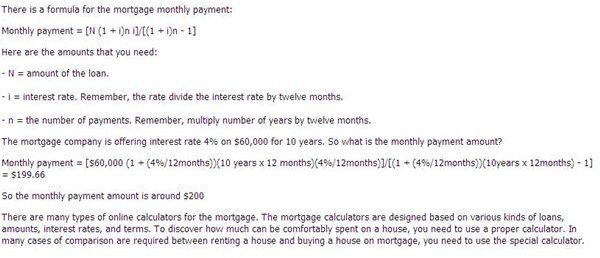How to Calculate Monthly Payments for a House Payment
Why You Should Care
Knowing how to calculate monthly mortgage payments is one of those things people never really think about. The mortgage bill comes in the mail or email every month and you just pay what the statement says you owe. However, harsh economic times exacerbated by the housing crisis, is making people more aware of the importance of knowing how to calculate monthly payments for a house payment. In addition to making you more in control of your finances, and obtaining vital knowledge about what accounts for the mortgage bill each month, learning this calculation also helps you catch the occasional billing error made by the mortgage company. More importantly, it helps you know if you are getting a good deal or if you should be working on reducing your mortgage cost. Finally, when you know how to calculate your monthly mortgage payment you can decide to make extra mortgage payments to pay off your loan sooner.
There are two ways of calculating monthly mortgage payments: manually using a financial calculator and a spreadsheet which you configure, or automatically, by using an online calculator or preconfigured spreadsheet.
Calculating Your Monthly Mortgage Payment Manually

In order to learn how to calculate monthly payments for a house payment, you need a financial calculator and a few figures. These include, the principal value of the loan, the interest rate, and the term of the loan. Let’s illustrate how to do this using an example of a $200,000 house to be purchased with a 30-year mortgage at a 6 percent interest rate requiring a 20 percent down payment. Here are the steps to follow:
- Calculate the principal value of the loan - In this case, this will be 80 percent of $200,000 or $160,000, since the mortgage requires a 20 percent down payment.
- Calculate the monthly payment - Using a financial calculator, put in the value of the loan, the interest rate, and the length of the loan (in this case 30 years) to calculate the monthly payment. You will have to follow the instructions from your particular calculator for doing this. Your calculator will in turn compute the value of your monthly payment. Doing this will result in $959.28 as the monthly payment.
- Calculate the interest for the first month - The interest payment for the first month of the mortgage is calculated as follows: Principal times the interest rate divided by 12 = 160,000 x 6%/12 = $800. This means that $800 of the monthly payment for the first month will go toward interest while the balance of $159.28 will go toward paying off the principal. The value of the interest payment will reduce in each subsequent month as the principal balance on the loan reduces until it becomes zero and the loan is paid off. This process is known as amortization.
- Use the information in step 3 above to create an amortization table or amortization schedule - This gives you the value of the monthly payment each month stating what portion goes to pay off the principal and what portion covers the interest payment. Therefore in the second month of our example, the principal balance would be $159,840.72 ($160,000 - $159.28). Remember that of the $959.28 payment in the first month, only $159.28 went toward paying off the principal, while the greater share, $800 was an interest payment.
- Manual Computation - If you click on the screenshot in the upper right, you can see an example on how to manually calculate your mortgage payment through preset mathematical computations.
Screenshot credit: Isnare.com (https://www.isnare.com)
Calculating Your Monthly Mortgage Automatically
The best way to calculate your mortgage payment automatically is to use an online calculator and or a pre-configured spreadsheet, which will also give you an amortization schedule. Bankrate has a good online mortgage calculator which also prepares an amortization table. You can also download a preconfigured spreadsheet available from Vertex42. In addition, you can get a pre-configured spreadsheet in the form of a template from some office productivity software programs such as Microsoft Word or download Microsoft Office templates directly from Microsoft.com. All you need to do is input the required values of principal, interest and length of mortgage and the calculator or spreadsheet will spit out your monthly payment and amortization schedule.
These automatically pre-configured spreadsheets are probably the easiest way to learn how to calculate monthly payments for a house payment.
Reducing Your Mortgage Cost and Paying Off Your Loan Early

Since you are borrowing a large sum of money over 30 years to buy a house you could otherwise not afford, it is expected that you pay for the use of the funds you borrow. That is why your bank charges you interest. However, over the life of the loan, the cost of your mortgage actually adds up to a lot of money. Using our example above, if you borrow $160,000 to buy a $200,000 house and pay it off in 30 years, you would have paid a total of $185,341.10 in interest (this amount is available in your amortization schedule). This means that would have paid more than $185,000 to borrow $160,000.
Now imagine you made an extra payment each month that is equivalent to an extra monthly payment a year. This will go a long way in significantly reducing your mortgage cost and paying off your loan early. So paying an extra $1000 each year would result in reducing your mortgage cost by $39,050.25 since you would reduce your total interest payment over the life of the loan by this amount. This will in turn result in you paying off your loan 6 years and 5 months early. You can use an online calculator to help you determine how much earlier you can pay off your loan by paying an extra amount each year, each month or even making a one-time only extra payment.
Please bear in mind that each mortgage company or bank has its policy on how extra payments are applied. Some automatically apply them to the principal while others will require that you send the payment to a separate address or specifically request that the payment be applied to your principal balance. Contact your bank or mortgage company when you plan on making extra mortgage payments.
By using these tips, you’ll soon learn how to calculate monthly payments for a house payment on your own. Finally, if you are making these calculations because you are contemplating buying a piece of property, do not forget to account for real estate taxes and insurance. Depending on the type of mortgage you have, sometimes these could be included in your mortgage payment.
Image Credits
- Home in palms / HomeMortgageLoanQuote.net
- House of dollars / Homeloans-UK
